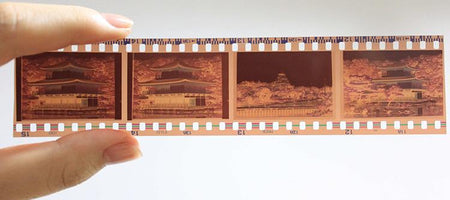Home movies are some of our greatest treasures. All of the sweet, beautiful, awkward, and silly moments caught on camera are prized possessions to each family. Often times, home movie collections are the best records of the past that we have. Photographs are great, but videos add an extra layer of authenticity to the event being recorded.
Videos transport us back to those times.
Home movie equipment has greatly changed over the years. From early film formats to the modern smartphone video, there’s a lot of evolution that has happened in between. Let’s look at all the most popular home movie equipment from years past.
17.5 mm Format
In 1898, photographer Birt Acres developed the 17.5 mm film format known as the “Birtac”. Birtac film was made by splitting 35 mm film strips in half. This made it more cost-effective than the traditional 35 mm format - you could record more frames of video with the same amount of film. The Birtac format could be loaded into a camera in daylight, something that could not be done with regular 35 mm film at the time. Mr. Acres developed a camera along with his film format that could print and project, further reducing costs and making his invention popular amongst amateur filmmakers and in the home movie market.
9.5 mm Format
In 1922, a new film format was introduced that excited the home movie market. The 9.5 mm film format, invented by the firm Pathe Freres in France, had sprocket holes in between each frame rather than along the outside of the film, which allowed the images on each frame to take up the entire width of the frame. This format was very popular for home moviemakers in the UK for decades.
16 mm Format
Launched by Eastman Kodak in 1923, the
https://southtree.com/blogs/artifact/history-of-16mm-film format became widely used for home movie making because of its safety. Previous film types were made with nitrate and were highly flammable. If stored improperly, these older films were known to spontaneously combust! So Kodak’s safety film became standard for non-professional use.
8 mm Format
The 8 mm format was introduced in 1932 and was, again, a reduction in size from previous formats. The 8 mm format fit four frames in one 16 mm frame, making it more cost-effective and thus attractive for home movie use. This format was the first that made movie-making an option for the average family.
Color Film
In 1935, Eastman Kodak launched its Kodachrome 16 mm film which had capabilities to record color on film. One year later they introduced an 8 mm version of Kodachrome. The introduction of color film was huge for both the professional and non-professional users.
Super 8 Film
The Super 8 film format, developed by Kodak in 1965, was an improvement to the earlier 8 mm format because of the Super 8’s larger frames. The larger frames allowed for better picture quality. Kodak also produced High-End Super 8 film, which incorporated a magnetic audio track for synchronized sound. This meant that folks’ home movies could have sound and color.
VHS and the Camcorder
With the invention of the VHS tape and camcorder that came in the 1970s and 80s, a new era of home movie making began. Compared to film, videocassettes were a lot cheaper, and they could be erased and re-recorded on. Most families had VCRs by the 80s and 90s and could easily playback their homemade movies on their televisions through their VCR systems. The VHS tape and camcorder made home movie making more affordable than ever and more accessible than ever.
Digital Video Cameras
By the 1990s, digital video cameras came onto the scene. Equipped with computer chips, these digital cameras increased video quality exponentially and made the transfer of video to digital easier than ever. In the early 2000s, digital video cameras replaced the camcorders of the 80s and 90s as the most popular format for home movie making. Many people still use digital video cameras for home movie making, although we are seeing this less and less.
Smartphones
Today, many families no longer own digital video cameras. Instead, they just use their smartphones for video recording. The quality of the smartphone camera has increased over the years, making smartphones a decent competitor against high-quality digital cameras. Instead of lugging around an extra camera to kids’ sporting events, weddings, and birthday parties, people today just pull their smartphones out of their pockets and take videos easily, no set up required.
Do you still use digital video cameras, or have you moved onto using smartphones only for video recording? There are still many individuals who prefer to use digital video cameras over smartphones for the quality of video that some high-end cameras can produce. However, the smartphone is a cost-effective option for many folks, as it combines a computer, a phone, and a video camera all in one device.













